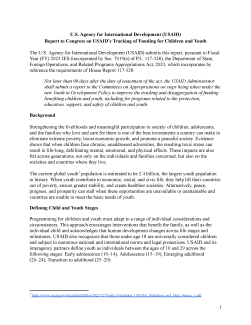The U.S. Agency for International Development (USAID) submits this report, pursuant to Fiscal Year (FY) 2023 JES (incorporated by Sec. 7019(e) of P.L. 117-328), the Department of State, Foreign Operations, and Related Programs Appropriations Act, 2023, which incorporates by reference the requirements of House Report 117-328:
Not later than 90 days after the date of enactment of the act, the USAID Administrator shall submit a report to the Committees on Appropriations on steps being taken under the new Youth in Development Policy to improve the tracking and disaggregation of funding benefiting children and youth, including for programs related to the protection, education, support, and safety of children and youth.
Background
Strengthening the livelihoods and meaningful participation in society of children, adolescents, and the families who love and care for them is one of the best investments a country can make to eliminate extreme poverty, boost economic growth, and promote a peaceful society. Evidence shows that when children face chronic, unaddressed adversities, the resulting toxic stress can result in life-long, debilitating mental, emotional, and physical effects. These impacts are also felt across generations, not only on the individuals and families concerned, but also on the societies and countries where they live.
The current global youth population is estimated to be 2.4 billion, the largest youth population in history. When youth contribute to economic, social, and civic life, they help lift their countries out of poverty, ensure greater stability, and create healthier societies. Alternatively, peace, progress, and prosperity can stall when these opportunities are unavailable or unattainable and countries are unable to meet the basic needs of youth.

